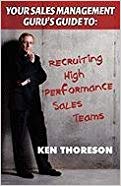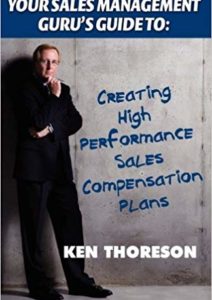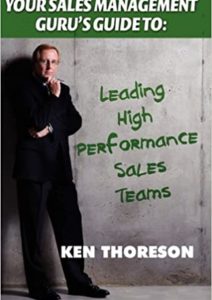“If you can find good people, they can always change the product/service. Nearly every mistake I’ve made has been in picking the wrong people, not the wrong idea. Most entrepreneurs have no problem coming up with a good strategy, but they usually need all the help they can get in developing and implementing the tactics that will make them successful in the long run.”
-Arthur Rock ,
Harvard Business Review, 1987
Selecting sales personnel is one of the biggest, if not THE biggest, challenge for any organization. Failure to achieve revenue targets, manage customer relations and delivery service can be traced directly to hiring people unequipped to carry out their assigned roles. Recruiting is a commitment; it should consume about a fifth of the sales leader’s time, and the process should be as well organized as the company’s sales methodology and forecasting systems. The following is taken from our online video training program for sales managers: http://www.acumenmgmt.com/TrainingCenter
Define the Ideal Profile
The key to building a winning sales organization is understanding whom you want to hire. Why? Because thorough development and analysis of the ideal sales representative profile heighten your chances of recruiting the right person. Here’s how you start:
- Make your own list of essential salesperson characteristics.
As the hiring manager, start by writing down your definition of a great sales representative. - Ask company leaders to make a list.
Ask management and members of the sales team to identify desirable sales traits. - Test your top sales representatives.
Ask your company’s most successful sales representatives to complete a personality profile or psychological test administered by an outside party. Record the data and look for common denominators among your top salespeople.
Reviewing the basic personality types often encountered in sales can provide additional insight into hiring effective sales representatives. “Hunter” (aggressive, accustomed to cold calling and inured to rejection) and “farmer” (stable, oriented to customer care) are common terms used to describe personalities in the sales world.
Understanding an applicant’s most typical behavior style when interacting with others can reveal how that person solves problems and makes decisions. And you may learn how flexible the applicant is in dealing with contrasting personality styles. The types:
Dominant—A dominant individual loves a challenge, and is always ready to take on the competition. Dominant people are direct, positive and straightforward. They continually seek new horizons and like to make decisions quickly. Some consider dominants restless because they become impatient and dissatisfied with the status quo. They are generally resourceful and adapt readily to new situations.
Cautious—Cautious people are basically humble, loyal and non-aggressive. They are usually conservative, slow to make decisions until they have absorbed all available information, and sticklers for detail. Cautious individuals want to be appreciated and will go to extreme lengths to avoid stepping on someone’s toes. They strive for a stable, ordered life and tend to be more task- than people-oriented.
Interactive—These individuals are outgoing, persuasive, gregarious and generally optimistic. Interested in people, they’re poised in social situations; at an initial meeting, they may greet you warmly by your first name, as if you’ve been friends for life. Interactive may act on emotional impulse, making decisions based on a cursory analysis because of their trust and willing acceptance of people.
Steady—Usually amiable, supportive and relaxed, steady individuals appear contented, even laid back. Patience and deliberateness are their defining characteristics. People high in steadiness strive to maintain the status quo and avoid rocking the boat. They value relationships that they have worked hard to establish and operate well in a team environment.
Matching the salesperson’s personality to the job—or even to the type of client he or she sees—makes sense. But remember that people often display characteristics of two or more personality profiles.
Measure the Profile
Once you’ve compiled all your information on the sales position and the applicant’s desired personality profile, boil it all down to five or seven objectives, measurable characteristics. Why so few? Because you need to focus on key responsibility areas that drive success. For example:
- Hundred percent quota achievement in four out of five sales jobs, for a minimum of five years
- Bright, articulate
- Experience in opening new territories
- Regional sales experience
- Specific industry expertise
Create a measurement scale for each characteristic, like this:
Ineffective Effective
-5 -4 -3 -2 -1 NA 1 2 3 4 5
and use it to rate each candidate during the interview session.
Don’t be fooled by the profile’s simplicity, or the fact that it measures only five characteristics. This is the distillation of sound input from numerous sources, a benchmark based on the personalities and performance of your top sales representatives. Focusing your work in an easy to understand, simple format places the emphasis on implementation and results. It’s important to make this profile document available to everyone involved in the interviewing process, including recruiting firms.
Critical Reminders
To derive the most benefit from your new recruiting tool, interview a minimum of three candidates for each position, and make sure that every interviewer in the process rates each candidate from -5 to +5. Continue to refine the profile by gathering input from both internal and external sources.
A highly motivated, successful sales organization are critical to generating revenue and margin growth year after year. For a company’s sales leaders, searching for great salespeople every day is a top priority and never-ending challenge. Studies show that successful sales managers spend 15 to 20 percent of their time on recruiting. Whether or not there’s an opening in your sales ranks, take the time to meet new candidates or reacquaint yourself with candidates whom you have been courting. When you least expect it, your top candidate may become available.
Striving for Consistency
Now that you have a plan to fill the pipeline with quality candidates, the next step is to systemize the process for choosing and winning the right candidate time after time. Communicating an established process for all involved parties not only saves time but sends a clear, unified message to candidates that this company has its act together, increasing their desire to join the sales team. The following model has worked consistently in the past. Consider it as a foundation for your sales recruitment process.
#1: Identify and document each stage in the interview process, and who (at least three people) in your company will participate.
#2: Perform personality testing on your top sales reps. This provides a benchmark for evaluating candidates in one-on-one interviews.
#3: Distribute to all participants:
- Outline of the interview process
- Ideal sales candidate profile
- Interviewing scorecard
- List of base questions to ask every candidate
- The candidate’s resume
It takes an effort to build a recruiting process, and even more to ensure that everyone follows the plan. But the result—the creation of a winning sales team—is guaranteed to make life less stressful for any sales leader!
This article was originally published on the Acumen Management Blog.







